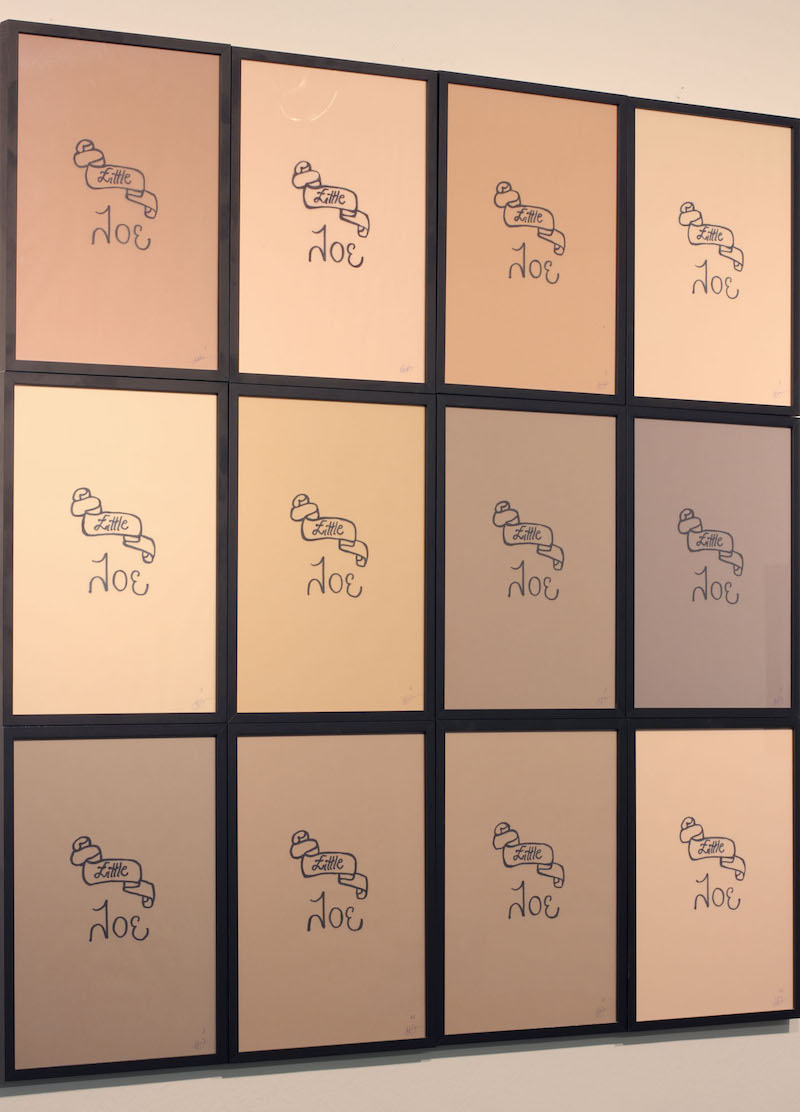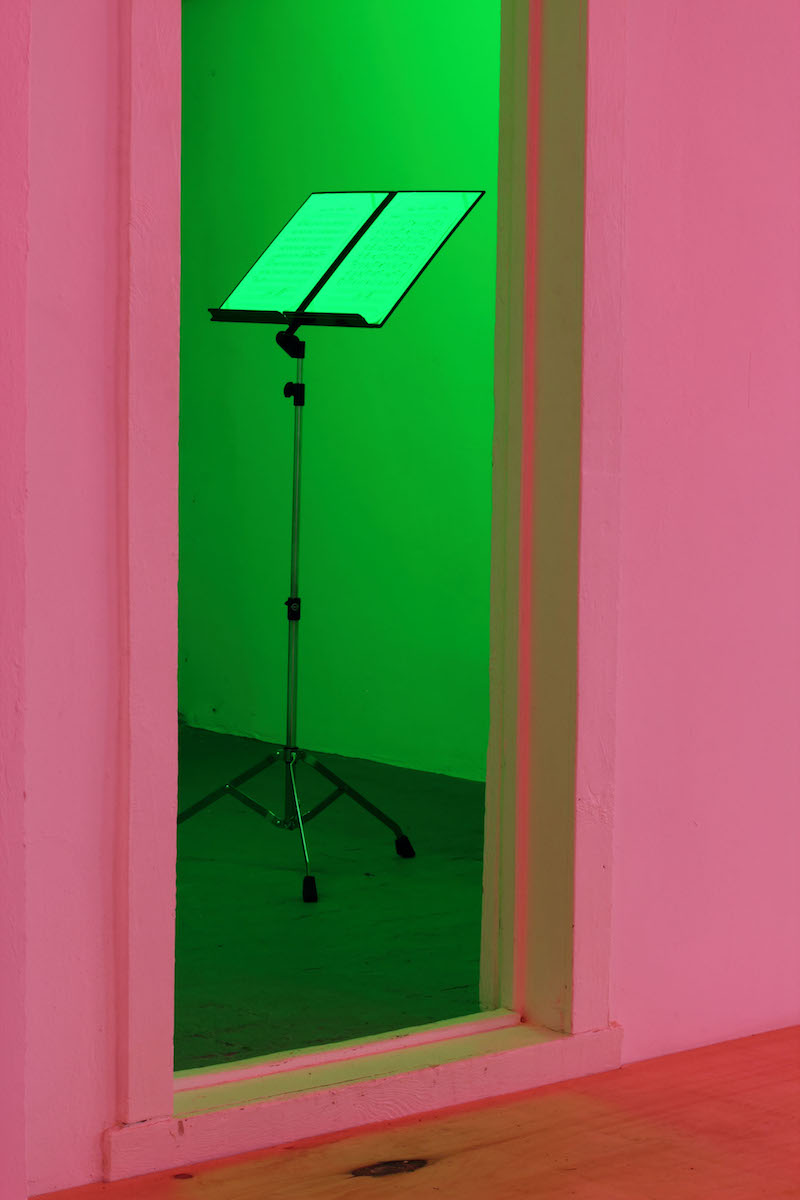 Hajnal Németh, installation view, Galerie Patrick Ebensperger, Berlin, 2016
Hajnal Németh, installation view, Galerie Patrick Ebensperger, Berlin, 2016
Courtesy of the artist
In her artistic practice Hajnal Németh creates musicals, operas, performances, films and photographs but most of all, through slight modifications of poems, songs and texts she encourages political statements. In her current exhibition “White Song – Among Others” at Galerie EBENSPERGER in Berlin, Németh discusses political systems and prevailing normative beliefs in current Western societies without framing the topic in a heavy format, but rather by bobbing and weaving with a bitterly humoristic approach coated in cultural and historical references.
Helene Romakin: In your artistic practice you often use music as a reference or as a method of expression. When did you start to work with musicians and create music-based performances?
Hajnal Németh: Before I came to Berlin in I was working a lot with photography. Especially, wallpapers played an important role because I liked the constant reproduction process of original images and to be able to expand in size. Also, wallpapers allow to experiment with aesthetical outcome, which I enjoyed. When I arrived in Berlin in 2002, I changed my method and approach to implement my ideas and started working mostly with time-based media. I realized my first live performances with musicians back then.
HR: Obviously, objects, music and performances reach the audience in different ways. How do you decide which ideas should be presented through which media?
HN: All my works are connected even though they represent different media. Certainly, a performance reaches the viewer through a different channel than a photograph. I basically use various media as different channels for the same content. For some people performance seems to be catchier while others feel intimidated … Usually, to represent one idea I work simultaneously with different formats until it becomes one message. I like to give the audience the possibility to receive my ideas in a way they feel more attracted to it. Also, I believe, in a video or a performance the viewer is much more dominated or guided by the artist’s subjective perspective while photographs leave more space for interpretation. All works, no matter of their format, are complementary to each other and serve the idea to create one statement.

Hajnal Németh, installation view, Galerie Patrick Ebensperger, Berlin, 2016
Courtesy of the artist
HR: In your current show it seems as you were mixing both practices …
HN: For this show beside the musical, I wanted to work with two-dimensional works that are on their way to become wallpaper but just not yet. However, still repetitive formal elements in a wallpaper-like style are very present again.

Hajnal Németh, “Work Song – As Times Goes By,” Video Still, 2016
Courtesy of the artist
HR: One of your new works in the exhibition is a 70 minutes long film that represents an audition for a musical. Usually, you work closely with references to existing songs and in close collaboration with actors and singers. Could you speak more about the production process of this work?
HN: Yes, this work is the final product of an idea I have already started to work on in Rome in 2013. The musical “Work Song” was a live presentation in a theatre in Rome. Later I realized a second version in Berlin. While all versions differ formally from each other, they all have the subject “work” in common. In all versions I ask about alternatives in life and how individuals deal with time and money and how these basic issues influence their lives. “Work Song – As Time Goes By” is a fictional musical that represents an auditioning situation, a casting for a musical. All participants are applying for a role in a musical but it is also a bit like applying for a role in life. It is about asking yourself what you want to be. An architect, you could be a poet, an actor, if you want to be a man instead of a woman and vice versa. These are little and big roles in life. In a way the set works as a metaphor of life compressed into a musical. Depending on the candidate and the role, he or she has applied for, I chose a specific song to be performed. For the actress who is applying for a role as a man, I interpreted the text from the autobiography of Nico (Velvet Underground) and updated it to the contemporary context. Another actor is being cast for the role as an architect. He performs an extract from “Walden” by the philosopher Henry David Thoreau from 1854. In this text Thoreau asks how you can live within a society with such rigid and hardened systems or further, how you can escape the status quo? In his life, he decided to exclude himself from the civilised society and to live alone in the nature without money and by avoiding the Industrial Revolution. It was his form of protest and critic on the government. In some parts of his writings, he also talks about architecture and building cities, the structure of life and time as well as how we allow to be organised by it.
HR: How should we imagine the musical? Will it be a classical musical with dancing parts?
HN: No, it’s not a musical in that sense. There won’t be a dance choreography but the casting process builds its own choreography, of course. In creating this moment, I was inspired by the movie “Taking Off” by Milos Forman from 1971, where he shows pictures of a casting situation. Coincidently, it is also a film about teenagers of the Hippie Generation, their intent revolution against the parents. The situation is very funny since it was a “real” casting where the participants believed to be cast for a real music production.
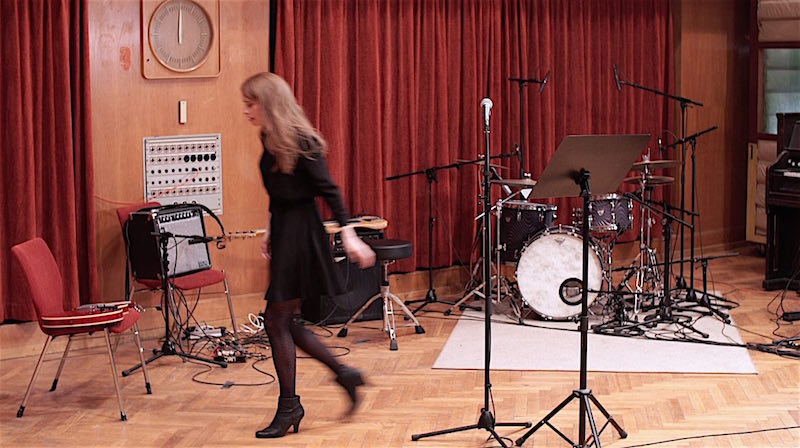
Hajnal Németh, “Work Song – As Times Goes By,” Video Still, 2016
Courtesy of the artist
HR: In the show you also refer to several pop songs from the 1970s. Could you speak more about your new work “White Song – Among Others (Race Abstraction)?”
HN: The verses on the four photos shown in the exhibition are taken from Roy Harper's song “I Hate The White Man”. It was released in 1970. In this song Harper explains why he hates the “White Man” in very significant poems that mention all destructive actions of white men against other races in this world. I found this song very strong and beautiful since Harper is a musician who strongly criticizes Western societies while being a British white man himself. Harper raises a very ambivalent question while he seems to be caught in his origins.
From this song I abstracted single parts from the refrain and changed the colour to red, yellow and black: "For I hate the red, man, in its evergreen excuse and I hate the white, man, in its doctrinaire refuse, for I hate the yellow, and its plastic excuse and I hate the black, man, it turned itself loose.” Since I introduced a comma after the colour, I changed the meaning of the sentence: “I hate the black, man!” simply means I hate the black colour referring to the man who I talk to. The abstraction of the meaning – in fact, of the entire song – lead to the subtitle “Race Abstraction” in my work.
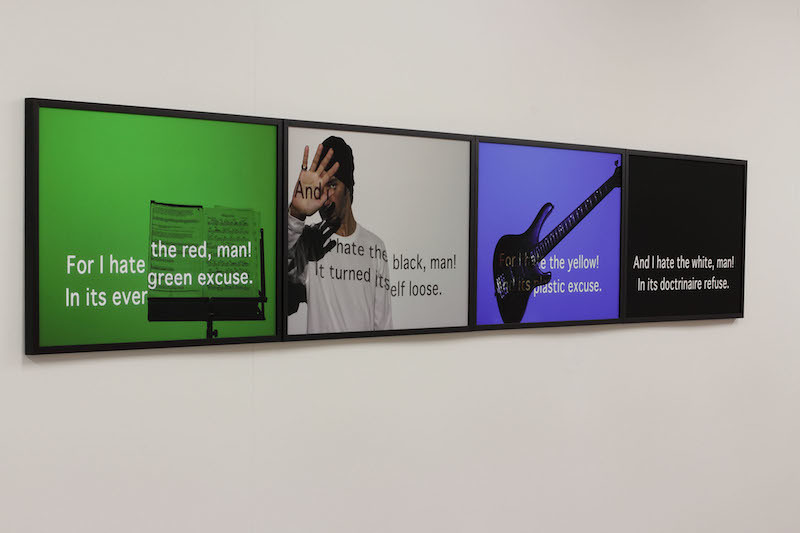
Hajnal Németh, “White Song – Among Others (Race Abstraction),” 2016
Courtesy of the artist
HR: The timing to introduce this topic after the heated elections in the United States and the strong right wing movement throughout Europe couldn’t be more relevant. Do you see your work as political?
HN: I am absolutely political. What you can read out of my work is a very reduced and minimized idea but it is still meant to be political–not by reflecting actual happenings but in generally applicable, abstracted way.
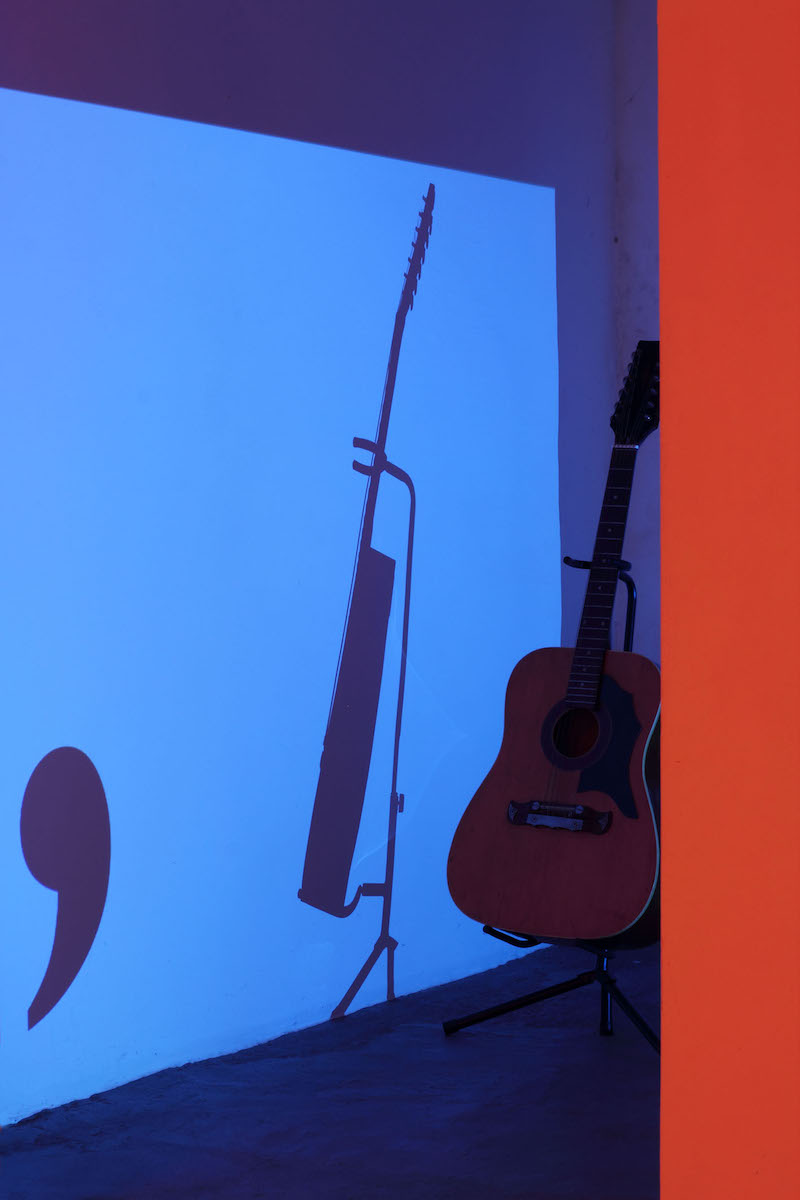
Hajnal Németh, installation view, Galerie Patrick Ebensperger, Berlin, 2016
Courtesy of the artist
HR: The four photographs, a two dimensional work, look like a staged performance or at least have a strong performative impulse …
HN: That’s true. On the images you see Albert Orgon, a singer and a musician, his scores for rehearsing and his bass guitar. He also worked on a version of Roy Harper’s song, which will be presented on a music stand together with his guitar in the exhibition. Since he will also take part in the opening, all elements will come together maybe not as a performance but a still life. The most important in this project was for me to project the modified sentences onto an object. In this case a human being becomes an object while the text is projected on his body. This gesture follows the same idea as the abstraction of the text white man, red man and the colour: A kind of materialisation, a depersonalisation of the human body through the projection of subtitles like in a cinema, an effect where suddenly the work becomes three dimensional. By translating texts to images I wanted to reverse verbal content to a visual content. In my opinion, text is strongly connected to its content while an image with text also works in an abstract way.
HR: The photos formally refer to Pop Art aesthetics. It seems to be a new approach in your artistic practice.
HN: If you think about it, I mostly use pop songs as references. In this sense I was always related to pop culture. However, formally I was never so explicit. This time it came out quite poppy. Long time ago when I just finished university and was working in Budapest, I did works following a pop art method when I worked with wallpapers… When I create two-dimensional works and it’s not documentation then it often has a strong pop art reference. The four photographs of “White Songs – Among Others” appear very loud through the chosen colours …
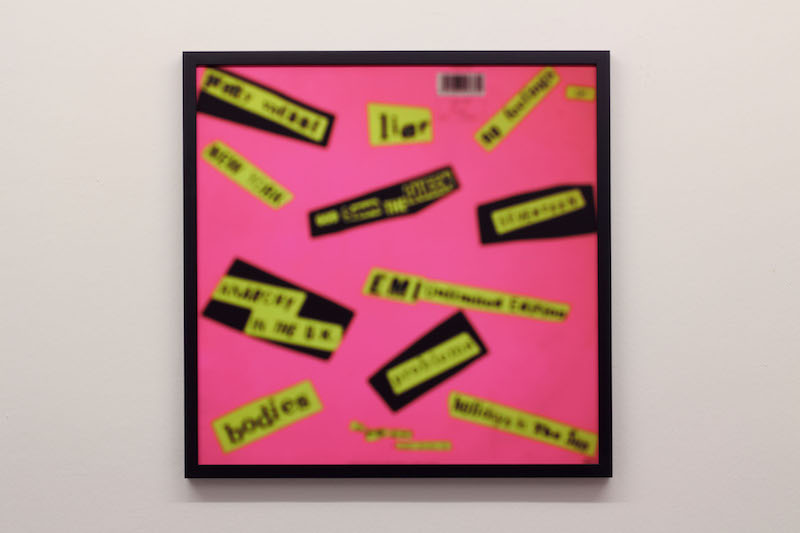
Hajnal Németh, “Dog Slave The Queen,” 2016
Courtesy of the artist
HR: That’s true. In the photograph “Dog Slave The Queen” you even use pink and yellow…
HN: Yeah, it's a very blurred and irritating reproduction. Do you know this music album cover? It is a back of the cover “Never Mind The Bollocks – Here’s The Sex Pistols” that included the song “God Save the Queen”. Again, I allowed myself to play with words.
HR: Sex Pistols were symbols of the protest of the labouring class against the establishment. As you mentioned before you discuss the aspects of work in capitalist societies in several of your works such as “Work Song – As Time Goes By” (2016), “Work Song” (2014), and “The Loser” (2013/15). In all works you talk about the individuals, who are affected in their social life by economic structures. Why do you always come back to this topic?
HN: The way economic structures are treating the life of individuals is antisocial and unfair. More precisely: From global economical aspects the individual life is being ignored and this attitude is controversial, because of course behind the global economical interests there are individuals. I was always interested in highlighting controversial things.
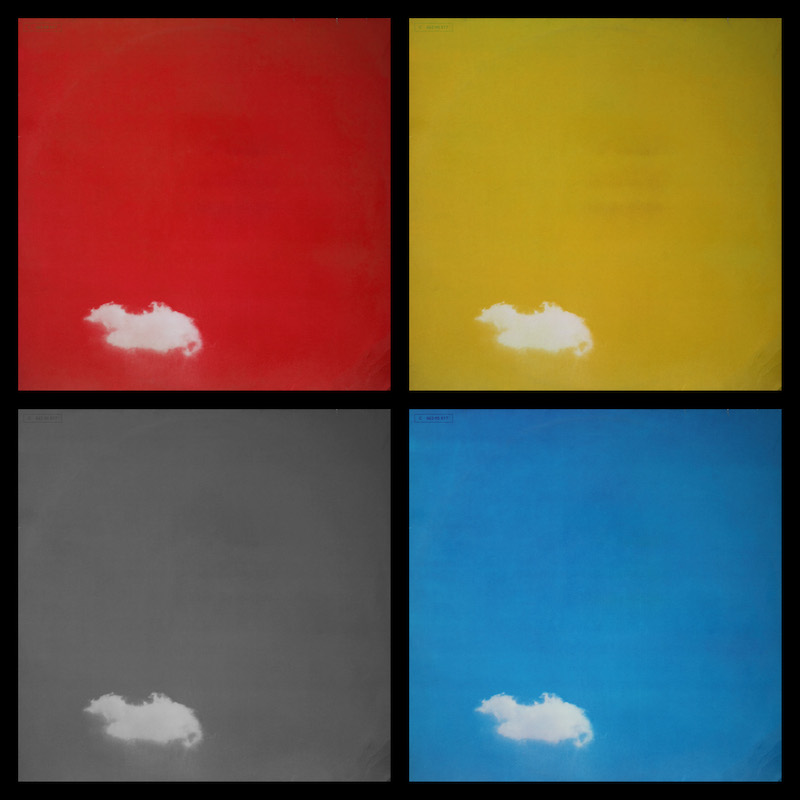
Hajnal Németh, “Peace Versions,” 2016
Courtesy of the artist
HR: Another photo series of four photographs is the work “Peace Versions” that shows an innocently looking cloud – always the same image but with modified colours in blue, grey, red and yellow …
HN: ...All motifs are enlarged reproductions of LP covers that again I modified minimally. The motif of “Peace Versions” is taken from the live album “The Plastic Ono Band – Live Peace“ by Yoko Ono recorded at the “Toronto Rock and Roll Revival“ festival in 1969. The colour of the original cover is naturally a very beautiful sky-blue. While changing the colours of the cover I was asking myself if peace could have different colours. Red sky would look very dangerous for example. Normally, I would say peace is peace. It shouldn’t have different colours or different versions at all.
Courtesy of the artist
HR: The only older work in the exhibition entitled “Tattoo All Of You” is a series of twelve graphics that shows always the same motifs but with different background colours. What is it about?
HN: The various white to beige and brown shades are metaphors for skin colours and the tattoo is an exact copy of Joe Dallesandro’s, a Warhol superstar, tattoo “Little Joe”, which he wears on his right upper arm. For me this work raises the question of the meaning of race and is very well connected to “White Song.” Also, I use the idea of the imperative “To Tattoo Somebody.” On one hand it means to define, to brand or label somebody and on the other hand, don’t forget, the dark sides in the history of the tattoos, concentration camps, for example. In this exhibition for me it was very important to work with found verbal elements and just modify them, in order to put a new punctuation or attention to another side of the possible meaning.
HR: It seems like you oft use individual destiny of iconic figures to draw a picture of the society, personal experiences become emblematic for larger structures …
HN: We are living in the age of crisis, but we often experience it as an individual crisis, a crisis of identity. It reminds me often of the song “Identity” by the punk band X-Ray Spex from 1978. I think it is difficult for us to identify with a society that is so strongly influenced by the capitalist system and its consumerist drive. Commercial societies lead to a homogenization of people. All over the world we buy the same products, wear the same clothes and listen to the same music. I believe, through this process a wrong similarity arises and we start to compare each other without considering our cultural background or heritage and thus, lose our sense of identity. In the exhibition I just wanted to show how important it is to be self-authentic and self-identic without criticising, but rather by raising the question.
HR: Do you believe we can influence or even produce change through art works or exhibitions in the prevailing hyper-individual world?
HN: My works aren’t any kind of speculation. Of course, I introduce and imply current philosophical questions that trouble me, but there is no specific political agenda behind it. My ideas come very naturally, and first of all I enjoy the process of creating. I always do what interests me most at that time and beside all this content, I really enjoy to work aesthetically in all formats we talked about. The best part of all seems to me the collaboration with individuals from other fields and the moment where we can discuss and exchange ideas. I don’t see the collaborators as only interpreters but creators of the final outcome. My motivation is always joy and that people still can enjoy what they are working on.
galerieebensperger.net
hajnalnemeth.com
galerieebensperger.net
hajnalnemeth.com

